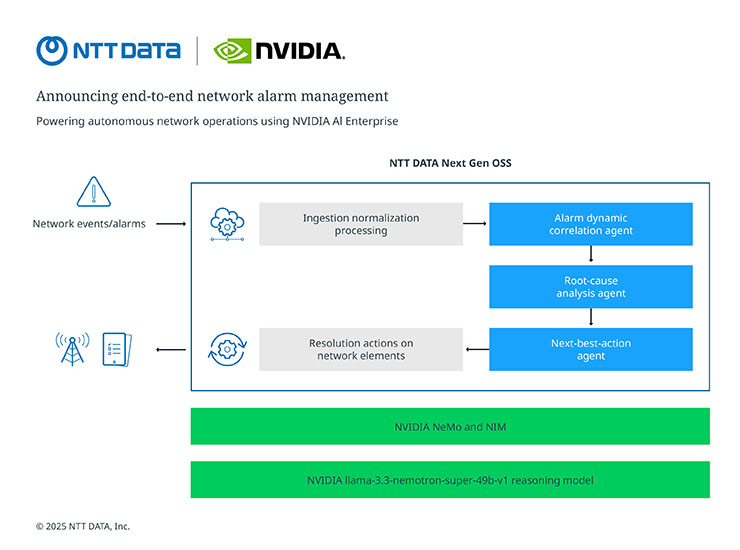-
Featured services
2026 Global AI Report: A Playbook for AI Leaders
Why AI strategy is your business strategy: The acceleration toward an AI-native state. Explore executive insights from AI leaders.
Access the playbook -
Services
View all services and productsLeverage our capabilities to accelerate your business transformation.
-
Services
Network Services
-
Services
Cloud
-
Services
Consulting
-
-
Services
Data and Artificial Intelligence
- AI and Intelligent Solutions
- Data/AI Strategy and Program
- Data Engineering and Platforms
- Data Governance and Management
- Data Visualization and Business Decision
- GenAI Consulting
- GenAI Platforms
- GenAI Industry Services
- GenAI Infrastructure Services
- GenAI Value Transformation
- View Data and Artificial Intelligence
-
Services
Infrastructure Solutions
-
Services
Global Data Centers
-
Services
CX and Digital Products
-
Services
Application Services
-
Services
Sustainability Services
-
Services
Digital Workplace
-
Services
Business Process Services
-
Services
Generative AI
-
Services
Cybersecurity
-
Services
Enterprise Application Platforms
![]()
Accelerate outcomes with agentic AI
Optimize workflows and get results with NTT DATA's Smart AI AgentTM Ecosystem
Create your roadmap -
-
-
Insights
Recent Insights
-
The Future of Networking in 2025 and Beyond
-
Using the cloud to cut costs needs the right approach
When organizations focus on transformation, a move to the cloud can deliver cost savings – but they often need expert advice to help them along their journey
-
Make zero trust security work for your organization
Make zero trust security work for your organization across hybrid work environments.
-
-
![]()
2026 Global AI Report: A Playbook for AI Leaders
Why AI strategy is your business strategy: The acceleration toward an AI-native state. Explore executive insights from AI leaders.
Access the playbook -
-
2026 Global AI Report: A Playbook for AI Leaders
Why AI strategy is your business strategy: The acceleration toward an AI-native state. Explore executive insights from AI leaders.
Access the playbook -
Discover how we accelerate your business transformation
-
About us
CLIENT STORIES
-
Liantis
Over time, Liantis – an established HR company in Belgium – had built up data islands and isolated solutions as part of their legacy system.
-
Randstad
We ensured that Randstad’s migration to Genesys Cloud CX had no impact on availability, ensuring an exceptional user experience for clients and talent.
-
-
CLIENT STORIES
-
Liantis
Over time, Liantis – an established HR company in Belgium – had built up data islands and isolated solutions as part of their legacy system.
-
Randstad
We ensured that Randstad’s migration to Genesys Cloud CX had no impact on availability, ensuring an exceptional user experience for clients and talent.
-
![]()
2026 Global AI Report: A Playbook for AI Leaders
Why AI strategy is your business strategy: The acceleration toward an AI-native state. Explore executive insights from AI leaders.
Access the playbook -
- Careers
Topics in this article
Telecommunications networks are the lifelines of business in our highly connected world, where data needs to flow freely. As these networks evolve, advanced technologies like AI are becoming essential for making them more efficient, reliable and adaptable.
At the forefront of this technological revolution, NTT DATA is creating agentic AI solutions that transform the way these networks operate.
Specifically, we’re developing an end-to-end network alarm-management solution, accelerated by NVIDIA, to improve efficiency and reliability.
Training models with domain-specific data
Our expertise is grounded in more than 40 years of AI research and development and nearly 75 years of preeminence in the telecommunications sector. This makes us uniquely qualified to create practical AI applications that address the industry’s specific challenges and opportunities.
One of our standout skills is fine-tuning AI models on vast amounts of network and telco data to build smart agents that handle tasks and make decisions with minimal human intervention. The resulting large telco models (LTMs) are the backbone of autonomous networks.
Using telco data to fine-tune these models is essential for creating intelligent agents that can manage complex network operations, predict network equipment failures and streamline resource allocation. This speeds up time to value and leads to more cost-effective solutions.
The value of agentic AI in telco networks
Agentic AI is a game changer, as it delivers a host of benefits that can dramatically boost network performance, efficiency and autonomy. One of the biggest advantages is that AI agents can take care of tasks like traffic management, resource allocation and maintenance without needing constant attention.
By automating these processes, agentic AI lightens the load on network operators, freeing them up to focus on more strategic tasks. For example, in the future, agentic AI could design a network and determine how many cells are needed in a coverage area. Solution engineers would then concentrate on verifying the design and tackling the next level of strategic requirements, building on the solid foundation provided by the AI agent.
Another key benefit of agentic AI is its predictive power. It can forecast equipment failures and schedule maintenance ahead of time, which means less downtime and a longer lifespan for your infrastructure. This proactive approach keeps your network running smoothly and saves you money by avoiding costly emergency repairs.
Agentic AI also improves the user experience. By understanding how users behave and what they prefer, it can dynamically allocate resources to meet real-time needs, creating a seamless, high-quality experience. Plus, it keeps a watchful eye on network traffic to spot security risks, adding an extra layer of protection.
Implementing agentic AI in telco networks brings significant cost savings, too. Automating routine tasks and optimizing resource allocation reduces your operational expenses. The technology also makes it easier to scale your network as demand changes.
An NVIDIA accelerated computing platform enabling agentic AI
To bring agentic AI to telecommunications networks, NTT DATA is using the NVIDIA AI Enterprise software suite, comprising powerful AI tools and frameworks. These make sure that AI models are portable, high-performing and cost-effective.
One of these tools is NVIDIA NIM, a collection of containerized inference microservices that provide simplicity, reliability and portability, making it easy to move AI model deployments between different environments, like on-premises and cloud platforms, without needing a lot of reconfiguration. This portability allows us to deploy AI models wherever they’re needed.
NIM microservices also come with an inference engine that ramps up inference performance, generating two to five times more token throughput. This means you get more bang for your buck — lower costs per token and higher performance without any drop in quality.
At NTT DATA, we’re leveraging NIM microservices in our next-generation alarm-management workflow for operations support systems. This setup automates and powers complex tasks like static and dynamic alarm correlation, root-cause analysis and closed-loop automation.
By adopting NIM microservices , we’re seeing a range of benefits: lower total cost of ownership, reduced latency, faster resolution times, less manual intervention and fewer customer complaints or missed issues. Telco operators get a clearer picture of network performance and can address issues before they become headaches.
- ALSO READ → How to modernize your network in 2025
A use case: Network alarm management using NIM
Processing network alarms, a critical daily task, has traditionally relied on static, rule-based systems that are rigid and often struggle to adapt to evolving network conditions or new patterns of failure. These conventional approaches, while reliable to a point, lack the flexibility needed for more dynamic and intelligent responses.
This is where large language models (LLMs) offer exciting new possibilities. With adaptive reasoning and contextual understanding, LLMs can help modernize alarm-processing workflows, making them more flexible, efficient and responsive to real-world complexity.
Now, we’re speeding up the adoption of AI in telco networks with a network alarm-management solution where NIM microservices form part of the operational support system’s fault-management workflows to automate and power complex tasks.
How it works
Using the NIM microservices’ REST application programming interfaces, the workflows ask the LLM for support on specific alarm-management tasks. These include static and dynamic alarm correlation, root-cause analysis and resolution recommendation, as well as the execution of automatic actions like ticketing creation — all of which can be covered by NIM. Meanwhile, telco data sources that span correlation rules, vendor documentation and historical incidents can provide the LLM with specialized knowledge.
NVIDIA employs reasoning models, including Llama-3.3-Nemotron-Super-49B-v1, that are trained for reasoning-based tasks such as retrieval-augmented generation (RAG) and tool calling — making them ideal for logical inference during alarm management.
By preparing the input data and using clear prompts that include requirements, expected output and business rules, the workflow powered by NIM microservices can generate the necessary data at each step of the alarm processing. Through prompt engineering, the LLM can produce more effective and coherent responses, boosting the correlations rate and the accuracy of resolution recommendations. This NIM-supported process minimizes manual intervention, speeds up issue resolution and helps identify hidden problems.
Other potential benefits of this process include the evolution and addition of functionality. For example, improving the agentic framework with a knowledge base of historical resolutions and documentation integration via RAG (including topology information for correlation analysis) and enabling tool calling features, along with prompt enhancements and performance optimizations, could create a truly powerful workflow. This would help telco operators manage the volume and complexity of alarms more effectively.
End-to-end network alarm management
How telco network operators stand to benefit
NTT DATA’s network assets, knowledge and experiences, combined with NVIDIA’s full-stack AI capabilities, introduce advanced automation features to help our clients develop autonomous networks.
The main goal of this use case is to reduce effort and costs in keeping networks operating correctly and efficiently. It also opens the door to more advanced applications across network domains, improving the autonomy of communication service providers’ networks. This will enable further savings and create new opportunities for network monetization.
By applying this solution, we anticipate an expansion in new automation use cases that will require deriving insights from large volumes of both network and non-network data. Additionally, it will demand low computational latency and machine-learning capabilities to dynamically adjust to network behavior.
Some of the benefits include:
- Network planning and smart capex allocation
- Network design (fixed network automatic routing design; initial radio access network configuration)
- Network deployment certification (incorporating computer vision and AI assistance for on-site tasks)
- Network traffic and quality prediction (self-optimization of the network and potential monetization of third-party applications)
- Predictive network maintenance
- Improved network performance management (low-latency use cases)
- Dark network operation-center capabilities (full automation of incident management)
We’re redefining how telco networks operate
NTT DATA’s expertise in AI and telecommunications, paired with the tools and capabilities provided by NVIDIA, is transforming the telecommunications industry with agentic AI solutions.
By automating network operations, predicting equipment failures and improving user experiences, agentic AI is making networks more efficient and autonomous. NVIDIA tools such as NIM microservices, NeMo and AI Blueprints — including a new NVIDIA AI Blueprint for telco network configuration — ensure that these AI models are portable, high-performing and cost-efficient, making them a valuable asset for telco networks.
As the telecommunications industry continues to evolve, integrating agentic AI will be key in meeting the growing demand for network efficiency and reliability. NTT DATA and NVIDIA are set to redefine how these networks operate in our increasingly digital and data-driven world.





